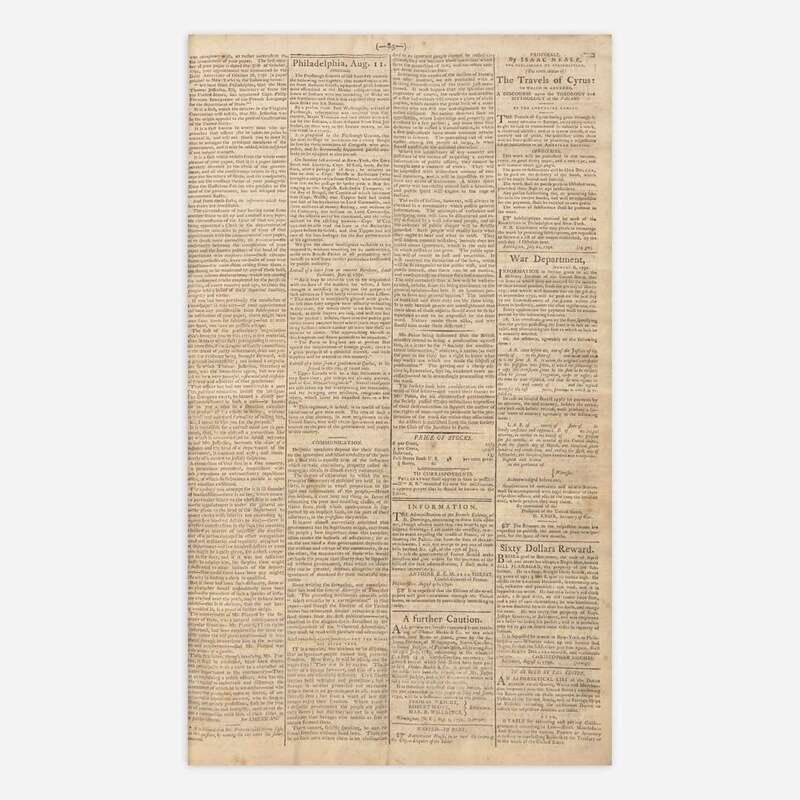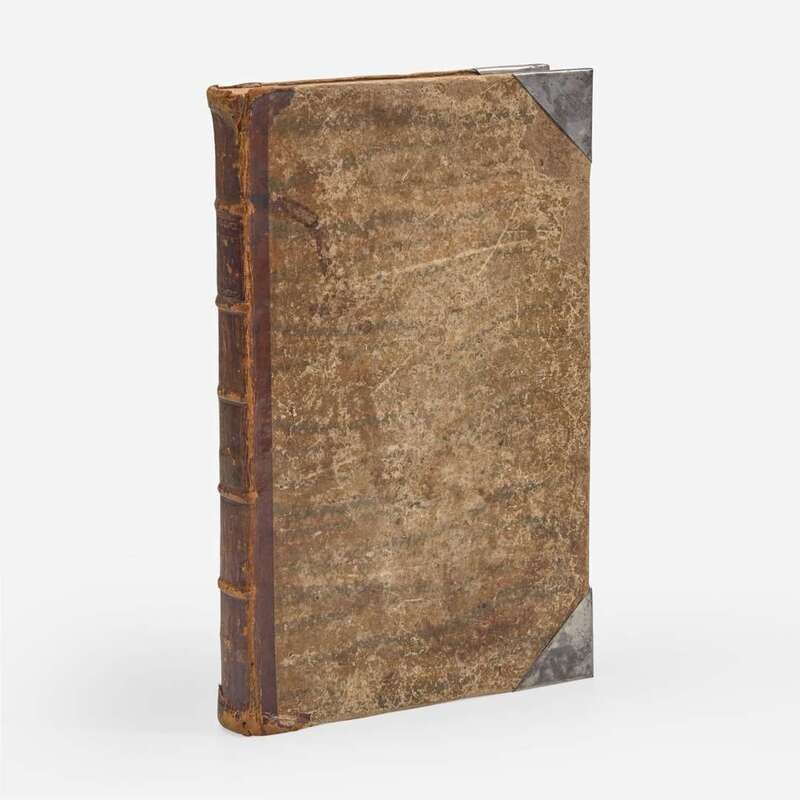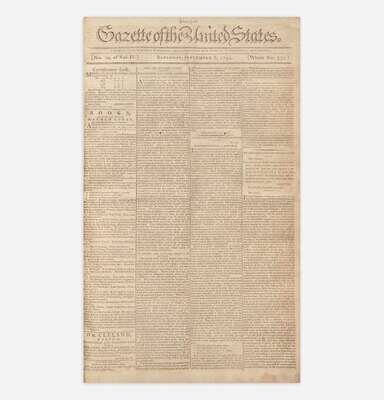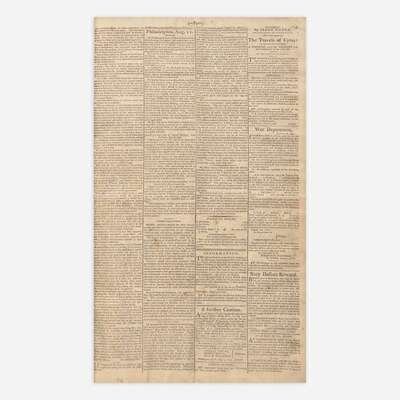Condition Report
Contact Information
Lot 19
Lot Description
The Dawn of Partisan Politics in America: An Extensive Collection of the Gazette of the United States
"But it may be asked--is it possible that Mr. Jefferson, the head of a principal department of the government can be the patron of a paper, the evident object of which is to decry the government and its measures?" -An American (Alexander Hamilton)
Philadelphia: John Fenno, Saturday, June 2, 1792-Saturday, September 14, 1793 (Nos. 1-135). A near-complete collection of Vol. IV of this important newspaper, comprising 131 (of 136) issues. Folio. 538 pp. (with continuous pagination). Seven issues incomplete, including: June 6, 1792 (pp. 7/8); September 15, 1792 (pp. 121/122, the first Catallus issue, but essay printed in full); October 24, 1792 (pp. 167/168); February 6, 1793 (pp. 287/288); March 27, 1793 (pp. 343/344); August 3, 1793 (pp. 491/492); and September 14, 1793 (pp. 539/540, the fourth Helvidius essay, but essay printed in full). Contemporary three-quarter brown calf over marbled paper-covered boards, red morocco spine label, stamped in gilt, later metal corners, boards and extremities rubbed. Wear on front paste-down from now removed book label; heavy creasing along center of first three issues, with scattered wear and open tears; loss in bottom corner pp. 9/10, affecting some text; pencil scrawl, p. 180, top of p. 181, bottom of p. 254; some scattered fading to text; scattered toning and offsetting; scattered minor creasing and short closed tears; final leaf (Helvidius essay) very creased. Five issues wanting: August 7, 1792 (pp. 77-80); February 3, 1793 (pp. 281-284); February 9, 1793 (pp. 287-292); May 22, 1793 (pp. 405-408); September 18, 1793 (pp. 539-542).
An extensive collection of 131 near-continuous issues of the Gazette of the United States, one of the most significant American newspapers of the late 18th century and printing many essays by Alexander Hamilton for the first time.
The 131 issues span the final nine months of George Washington's first term as the first president of the United States as well as the first six months of his second term. This was a critical period in the early republic that saw the emergence of national partisan politics, including the formation of early political alliances, that would later coalesce into America's first political parties. This early partisanship was encapsulated in the contentious intra-cabinet debates between Secretary of the Treasury Alexander Hamilton and Secretary of State Thomas Jefferson over the role the new government should play at home and abroad. By the summer of 1792 their dispute spilled over into the pages of this newspaper and others in what is one of the earliest partisan press wars in the United States. Increasingly critical and defamatory articles were penned by Hamilton, Jefferson, and their respective allies, that bitterly attacked their opponent's politics and integrity. The Gazette of the United States played a critical role in these events. As Hamilton's primary platform to voice his criticisms of Jefferson and his allies, and as one of the most popular newspapers of its day, the printing of these essays was instrumental in inculcating a newly emerging sense of partisan identity to its readers--and its detractors--and marked a crucial moment in the emergence of partisan politics in the United States.
This collection features upwards of 19 articles, some printed here for the very first time, that have been attributed to the pen of Hamilton and published under a variety of pseudonyms. These include: T.L. (July 25, August 1, 11, 1792), An American (August 4, 11, 18, 1792), Catullus (September 15, 19, 29; October 17; November 24; December 22, 1792), Metellus (October 24, 1792), and Fact (October 20, 1792), among likely others. Authorship of essays signed Detector, Americanus, and Candor, previously attributed to Hamilton, is now in doubt. Later essays by Hamilton in this volume include: Metellus (July 17, 1793), Civis (February 25, May 29, June 8, 1793), and No Jacobin (essay No. IX, August 31, 1793; reprint, it first appeared in another paper). Numerous other articles by Hamilton and Washington's supporters are also printed, all under a variety of pseudonyms, including William Loughton Smith's Scourge article of September 22, 1792. Essays in support of Jefferson also appear (some likely written with his tacit approval), including the important essay from Aristides (September 8, 1792), printed in response to Hamilton's An American essays, as well as the seven part essay, Vindication of Mr. Jefferson, attributed to James Madison and James Monroe (September 26, 29; October 13, 24; November 10, December 8, 1792; January 5, 1793), reprinted from another paper. Many other articles supportive of Jefferson and his allies positions are featured as well, likewise under numerous pseudonyms.
Significantly, this collection features a near-complete first printed appearance of the Pacificus-Helvidius essays, written by Hamilton and Madison, considered some of the most important writings on the Constitution in American history. It includes all seven of Hamilton's Pacificus essays (June 29; July 6, 10, 13, 17, and 27, 1793), and a partial-printing of four (of five) of Madison's Helvidius essays (Number I, Part I: August 24, 1793; Number I, Part II: August 28, 1793; Number II, August 31, 1793; Number III, Part I: September 7, 1793; Number III, Part II: September 11, 1793; Number IV: September 14, 1793, this issue severely creased and worn and lacking its second leaf, but essay is complete). The fifth and final essay which appeared in the September 18 issue, is wanting.
Other important domestic and international events are extensively reported: comprehensive coverage of the ongoing French Revolution and subsequent European wars; the second election and inauguration of President Washington, including his second inaugural address; news regarding French Minister Edmond Genet and the subsequent "Citizen Genet Affair"; what is likely the first newspaper appearance of Washington's Neutrality Proclamation; detailed coverage of the congressional investigations of Hamilton and the Treasury Department for purported corruption; likely the first newspaper appearance of the Constitution of the State of Kentucky; the laying of the cornerstone of the Executive Mansion, known as the White House after 1818; the foundation of the Insurance Company of North America, the oldest stock insurance company in the United States; conflict in the Northwest Territory, including reports of the Congressional investigation into the conduct of General Arthur St. Clair following his defeat at the Battle of the Wabash; the lead-up to the Whiskey Rebellion. Numerous proceedings and legislative acts of Congress, as well as reports from various departments of the government, are printed, with many likely their first appearance in newspaper form.
In 1789, with Hamilton's financial support, editor John Fenno began publishing the Gazette of the United States. It functioned as the semi-official newspaper of the new federal government, and largely published articles and essays covering Washington's administration, as well as other important local, national, and international news. By early 1791, Jefferson and Madison, frustrated after being out-maneuvered by Hamilton on numerous policy issues surrounding public debt and a national bank, sought to counter Hamilton in the press by establishing the country's first opposition newspaper, the National Gazette. They enlisted poet Philip Freneau to create the paper, and beginning in late 1791 he began publishing waves of articles critical of both Hamilton and Washington. By early summer 1792, this negative press ignited a fiery retort from Hamilton, who over the following six months unleashed a frenzy of essays severely critical of Jefferson and his allies. This public display of partisanship infuriated Washington and inflamed tensions within his cabinet and within Congress. By the end of 1792 opposition to Washington's administration hardened around Jefferson, Madison, and others primarily representing the South. These partisan and sectional divisions would continue to entrench themselves and slowly organize into what became the first political parties in the country--the Federalists and the Democratic-Republicans.
By 1793 the ongoing French Revolution engulfed Europe in war and enflamed partisan discord at home. As France and Great Britain engaged in an escalating conflict, the United States was endangered of becoming entangled in the matter. When French Minister Edmond Genet arrived to the United States in the spring of 1793 he whipped up American support for France, and tried to enlist American volunteers to fight in its war with Britain. Fearing the damage this could cause the young nation, on April 22, 1793, Washington issued his Neutrality Proclamation, stating that the United States "should with sincerity and good faith adopt and pursue a conduct friendly and impartial toward the belligerent Powers" (printed here in the April 24, 1793 issue). The Proclamation was met with criticism from many American's who supported revolutionary France and believed that the United States was duty-bound to aid an ally whose support proved so vital to secure their own independence. While public sentiment over the matter swirled, the President's authority to issue the proclamation was questioned in Congress, and inspired what is considered some of the most important Constitutional writing in American history: the Pacificus-Helvidius debates. Between June 29 and September 18, 1793, Hamilton, writing under the name Pacificus, and Madison, writing under the name Helvidius, published 12 essays in the Gazette of the United States that debated the scope of executive and legislative powers in regard to foreign policy. Although Hamilton and Madison had previously been political allies and were the chief authors of the famed Federalist Papers, their relationship had soured during the course of Washington's first term, over ideological matters.
In late summer 1793 a devastating yellow fever outbreak hit Philadelphia (see article in August 28 issue from the College of Physicians). Partisan rancor was brought to a temporary halt as most politicians fled to the safety of the countryside (the capital was temporarily relocated to Germantown, Pennsylvania) and most newspapers closed up shop. John Fenno suspended operations of the Gazette of the United States for three months following the issue of September 18, 1793, and in October Philip Freneau permanently shuttered the National Gazette. The Gazette of the United States resumed publication under Fenno on December 11, 1793 as a daily, and under a slightly different name, Gazette of the United States & Evening Advertiser. Due to this, and the resignation of Jefferson at the end of 1793, the partisan press war temporarily abated, but would resume in 1794 with the passage of the contentious Jay Treaty.
This is the first time this collection has ever appeared on the market, and it is one of the largest nearly-unbroken runs of this significant newspaper that we can locate ever coming to auction.















